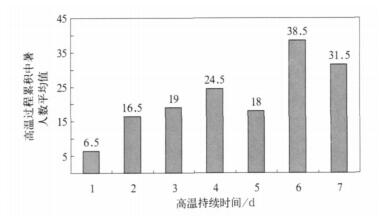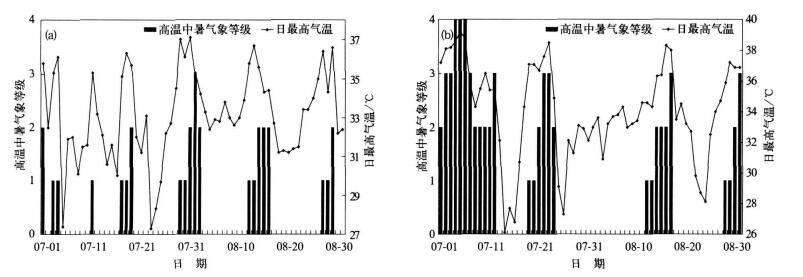高温中暑气象等级评定方法
An Evaluation Method of Heatstroke Grade with Meteorological Approaches
-
摘要: 在全球气候变化的大背景下, 高温热浪天气频繁出现, 由其引发的群发性中暑事件不断发生。为了有效预防极端高温天气对人体健康的影响, 利用全国358个重点城市1996-2005年逐日地面气象观测资料, 通过对气象要素与中暑的相关分析, 选择炎热指数为气象指标对引发中暑的气象条件进行了等级划分, 同时考虑不同程度高温天气的持续时间确定了高温中暑气象等级, 分别为可能发生中暑、较易发生中暑、易发生中暑和极易发生中暑4个等级。利用武汉市1994年和1995年7 -8月中暑人数与高温中暑气象等级进行对比分析, 结果表明:两者具有较好的对应关系。Abstract: An increase in the frequency of heat wave accompanies the global climatic change, and causes the continuous occurrence of grouped heatstroke. In order to reduce the impact of heat wave on human health, an index method for heatstroke meteorological forecast is established based on full research about the method of heatstroke both at home and abroad. The methods on heatstroke weather forecasting include index method, statistical analysis method and weather classification method. The method of statistical analysis is the most widely used now, but needs long-time series observation data. The statistical model is based on correlative analysis between case data and meteorological factors. The daily surface observation data of 358 cities from 1996 to 2005 are used, including daily maximum air temperature and daily average relative humidity. Daily numbers of heatstroke sufferers in Wuhan from June to August in 1994 and 1995 are adopted too. Then the correlation between meteorological factors and heatstroke cases is analyzed, and the heat index is chosen as meteorological index to grade with the method of quartile division considering the climatic background of different regions. Four grades of heatstroke are determined by the daily maximum air temperature and the duration of different high temperature weather condition. The correlations between grades of heatstroke forecast and daily numbers of heatstroke sufferers in Wuhan during July to August of 1994 and 1995 are analyzed, and the grades are also compared with daily maximum temperature. Moreover, days of each grade of heatstroke are statistical analyzed from 1996 to 2005. The results suggest that the grades reflect the influence of weather conditions upon heatstroke reasonably. The method on grading prediction of heatstroke can be applied to the actual operation. Many domestic provincial meteorological bureaus have started heatstroke forecasting research and service these days. However, it is hard to form a national uniform standard due to the vast territory and regional differences of climatic background. The method of quartile division takes different climatic background into consideration, so the standard of heatstroke forecast is graded all over the country. The error is reduced through this method to a certain extent and it provides technique foundation for developing national operational heatstroke forecast method.
-
Key words:
- heatstroke;
- heat index;
- forecast
-
表 1 炎热等级划分表
Table 1 Heat grade allocation table

表 2 高温中暑气象等级划分表
Table 2 Meteorological grades allocation table of heatstoke

表 3 高温中暑气象等级发布次数统计表 (单位:d)
Table 3 Frequency statistics on meteorological grades of heatstroke (unit:d)

-
[1] 孙颖, 王长科, 许红梅, 等.直面气候挑战——解读政府间气候变化专门委员会 (IPCC) 第四次评估报告.中国减灾, 2007, 7:8-9. http://www.cnki.com.cn/Article/CJFDTOTAL-ZGJI200707007.htm [2] 沈永平.IPCC WGI第四次评估报告关于全球气候变化的科学要点.冰川冻土, 2007, 29(1):156. http://www.cnki.com.cn/Article/CJFDTOTAL-BCDT200701023.htm [3] 谈建国, 黄家鑫.热浪对人体健康的影响及其研究方法.气候与环境研究, 2004, 9(4):680-686. http://www.cnki.com.cn/Article/CJFDTOTAL-QHYH200404011.htm [4] The Health Impacts of 2003 Summer Heat-waves. Briefing Note for the Delegations of the Fifty-third Session of the WHO Reginonal Commottee for Europe.2003, 9:1-12. [5] 陈正洪, 王祖承, 杨宏青, 等.城市暑热危险度统计预报模型.气象科技, 2002, 30(2):98-104. http://www.cnki.com.cn/Article/CJFDTOTAL-QXKJ200202006.htm [6] 刘熙明.美国热浪预报服务简介 (摘译).江西气象科技, 2003, 26(2):45-47. http://www.cnki.com.cn/Article/CJFDTOTAL-HXQO200302015.htm [7] 董蕙青, 黄香杏, 郑宏翔.中暑指数预报.广西气象, 2000, 21 (2):47-48. http://www.cnki.com.cn/Article/CJFDTOTAL-GXQX200002016.htm [8] 乔盛西.武汉中暑人数与体感温度、CDH的关系以及中暑发病的预报.湖北气象, 1992, 11(2):29-32. http://www.cnki.com.cn/Article/CJFDTOTAL-HBQX199202024.htm [9] 张德山, 邓长菊, 尤焕苓, 等.北京地区中暑气象指数预报与服务.气象科技, 2005, 33(6):574-576. http://www.cnki.com.cn/Article/CJFDTOTAL-QXKJ200506020.htm [10] 焦艾彩, 朱定真, 陶玫, 等.南京地区中暑天气条件指数研究预报.气象科学, 2001, 21(2):246-252. http://www.cnki.com.cn/Article/CJFDTOTAL-QXKX200102017.htm [11] Tom E C, Bosen J R. The discomfort index. Weatherwise, 1959, 12:59-60. http://vdi.sagepub.com/external-ref?access_num=10.1080/00431672.1959.9926960&link_type=DOI [12] 夏立新.郑州市人体舒适度预报.河南气象, 2000, 2:30. http://www.cnki.com.cn/Article/CJFDTOTAL-HNQX200002020.htm [13] 董蕙青, 黄海洪, 黄香杏, 等.南宁市"人体舒适度"预报系统.广西气象, 1999, 20(3):37-40. http://www.cnki.com.cn/Article/CJFDTOTAL-GXQX199903016.htm [14] 陈正洪, 王祖承, 张鸿雁.炎 (闷) 热指数在武汉市的试用、修订及检验.湖北气象, 2000, 3:23-25. http://www.cnki.com.cn/Article/CJFDTOTAL-HBQX200003009.htm [15] Tan Jianguo, Kalkstein L S. An operational heat/ health warning system in Shanghai. Int J Biometeorol, 2004, 48:158. doi: 10.1007/s00484-003-0193-z [16] Hyndman R J, Fan Y. Sample quantiles in statistical packages. The American Statistician, 1996, 50(4):361-365. https://www.researchgate.net/publication/222105754_Sample_Quantiles_in_Statistical_Packages -


 设为首页
设为首页 加入收藏
加入收藏



 下载:
下载:




